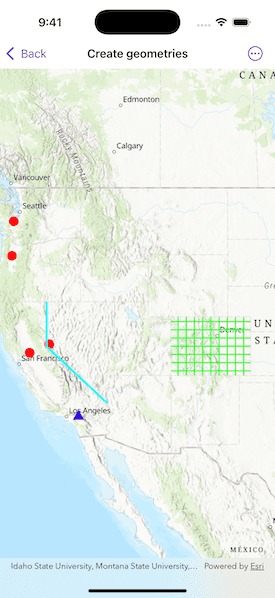Create simple geometry types.

Use case
Geometries are used to represent real world features as vector GIS data. Points are used to mark specific XY locations, such as landmarks and other points of interest. Polylines are made up of 2 or more XY vertices and can be used to mark roads, flight paths, or boundaries. Polygons are made up of 3 or more XY vertices and can be used to represent a lake, country, or a park. Geometries can be stored as features in a database, displayed as graphics in a map, or used for performing spatial analysis with GeometryEngine or a GeoprocessingTask.
How to use the sample
Pan and zoom freely to see the different types of geometries placed onto the map.
How it works
- Use the initializers for the various simple
Geometrytypes includingPoint,Polyline,Multipoint,Polygon, andEnvelope. - To display the geometry, create a
Graphicpassing in the geometry, and aSymbolappropriate for the geometry type. - Add the graphic to a graphics overlay and add the overlay to a map view.
Relevant API
- Envelope
- Multipoint
- Point
- PointCollection
- Polygon
- Polyline
Additional information
A geometry made of multiple points usually takes a PointCollection as an argument or is created through a builder.
Tags
area, boundary, line, marker, path, shape
Sample Code
// Copyright 2025 Esri
//
// Licensed under the Apache License, Version 2.0 (the "License");
// you may not use this file except in compliance with the License.
// You may obtain a copy of the License at
//
// https://www.apache.org/licenses/LICENSE-2.0
//
// Unless required by applicable law or agreed to in writing, software
// distributed under the License is distributed on an "AS IS" BASIS,
// WITHOUT WARRANTIES OR CONDITIONS OF ANY KIND, either express or implied.
// See the License for the specific language governing permissions and
// limitations under the License.
import ArcGIS
import SwiftUI
struct CreateGeometriesView: View {
/// The map shown in the map view.
@State private var map: Map = {
let map = Map(basemapStyle: .arcGISTopographic)
// Makes an envelope to use as the map viewpoint.
let envelopeBuilder = EnvelopeBuilder(
envelope: Envelope(xRange: -123.0 ... -101.0, yRange: 33.5 ... 48.0, spatialReference: .wgs84)
)
envelopeBuilder.expand(by: 1.1)
// Set the initial viewpoint of the map.
map.initialViewpoint = Viewpoint(boundingGeometry: envelopeBuilder.toGeometry())
return map
}()
/// The graphics overlay used to show the geometries.
@State private var graphicsOverlay: GraphicsOverlay = {
let graphicsOverlay = GraphicsOverlay()
// Makes a point using x, y coordinates and a spatial reference.
let point = Point(x: -117.195800, y: 34.056295, spatialReference: .wgs84)
// Makes a multi point geometry.
let multipoint = Multipoint(points: [
Point(x: -121.491014, y: 38.579065, spatialReference: .wgs84), // Sacramento, CA
Point(x: -122.891366, y: 47.039231, spatialReference: .wgs84), // Olympia, WA
Point(x: -123.043814, y: 44.93326, spatialReference: .wgs84), // Salem, OR
Point(x: -119.766999, y: 39.164885, spatialReference: .wgs84) // Carson City, NV
])
// Makes a polyline.
let polyline = Polyline(points: [
Point(x: -119.992, y: 41.989, spatialReference: .wgs84),
Point(x: -119.994, y: 38.994, spatialReference: .wgs84),
Point(x: -114.620, y: 35.0, spatialReference: .wgs84)
])
// Makes a polygon.
let polygon = Polygon(points: [
Point(x: -109.048, y: 40.998, spatialReference: .wgs84),
Point(x: -102.047, y: 40.998, spatialReference: .wgs84),
Point(x: -102.037, y: 36.989, spatialReference: .wgs84),
Point(x: -109.048, y: 36.998, spatialReference: .wgs84)
])
// Creates symbols for drawing graphics.
let pointMarkerSymbol = SimpleMarkerSymbol(style: .triangle, color: .blue, size: 14)
let multipointMarkerSymbol = SimpleMarkerSymbol(style: .circle, color: .red, size: 14)
let lineSymbol = SimpleLineSymbol(style: .solid, color: .cyan, width: 3)
let fillSymbol = SimpleFillSymbol(style: .cross, color: .green, outline: nil)
// Adds a graphic of point, multipoint, polyline and polygon.
graphicsOverlay.addGraphic(Graphic(geometry: point, symbol: pointMarkerSymbol))
graphicsOverlay.addGraphic(Graphic(geometry: multipoint, symbol: multipointMarkerSymbol))
graphicsOverlay.addGraphic(Graphic(geometry: polyline, symbol: lineSymbol))
graphicsOverlay.addGraphic(Graphic(geometry: polygon, symbol: fillSymbol))
return graphicsOverlay
}()
var body: some View {
MapView(map: map, graphicsOverlays: [graphicsOverlay])
}
}
#Preview {
CreateGeometriesView()
}